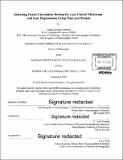| dc.contributor.advisor | Carl Wunsch. | en_US |
| dc.contributor.author | Amrhein, Daniel Edward | en_US |
| dc.contributor.other | Woods Hole Oceanographic Institution. | en_US |
| dc.date.accessioned | 2017-02-22T19:02:52Z | |
| dc.date.available | 2017-02-22T19:02:52Z | |
| dc.date.copyright | 2016 | en_US |
| dc.date.issued | 2017-02-22 | |
| dc.identifier.uri | http://hdl.handle.net/1721.1/107085 | |
| dc.description | Thesis: Ph. D., Massachusetts Institute of Technology, Department of Earth, Atmospheric, and Planetary Sciences, 2016. | en_US |
| dc.description | Ph. D. Joint Program in Oceanography (Massachusetts Institute of Technology, Department of Earth, Atmospheric, and Planetary Sciences; and the Woods Hole Oceanographic Institution), 2012 | en_US |
| dc.description | Cataloged from PDF version of thesis. | en_US |
| dc.description | Includes bibliographical references (pages 179-192). | en_US |
| dc.description.abstract | Since the Last Glacial Maximum (LGM, ~ 20,000 years ago) air temperatures warmed, sea level rose roughly 130 meters, and atmospheric concentrations of carbon dioxide increased. This thesis combines global models and paleoceanographic observations to constrain the ocean's role in storing and transporting heat, salt, and other tracers during this time, with implications for understanding how the modem ocean works and how it might change in the future. -- By combining a kinematic ocean model with "upstream" and "downstream" deglacial oxygen isotope time series from benthic and planktonic foraminifera, I show that the data are in agreement with the modem circulation, quantify their power to infer circulation changes, and propose new data locations. -- An ocean general circulation model (the MITgcm) constrained to fit LGM sea surface temperature proxy observations reveals colder ocean temperatures, greater sea ice extent, and changes in ocean mixed layer depth, and suggests that some features in the data are not robust. -- A sensitivity analysis in the MITgcm demonstrates that changes in winds or in ocean turbulent transport can explain the hypothesis that the boundary between deep Atlantic waters originating from Northern and Southern Hemispheres was shallower at the LGM than it is today. | en_US |
| dc.description.statementofresponsibility | by Daniel Edward Amrhein. | en_US |
| dc.format.extent | 192 pages | en_US |
| dc.language.iso | eng | en_US |
| dc.publisher | Massachusetts Institute of Technology | en_US |
| dc.rights | MIT theses are protected by copyright. They may be viewed, downloaded, or printed from this source but further reproduction or distribution in any format is prohibited without written permission. | en_US |
| dc.rights.uri | http://dspace.mit.edu/handle/1721.1/7582 | en_US |
| dc.subject | Joint Program in Oceanography. | en_US |
| dc.subject | Earth, Atmospheric, and Planetary Sciences. | en_US |
| dc.subject | Woods Hole Oceanographic Institution. | en_US |
| dc.subject.lcsh | Oxygen Isotopes | en_US |
| dc.subject.lcsh | Marine sediments | en_US |
| dc.title | Inferring ocean circulation during the last glacial maximum and last deglaciation using data and models | en_US |
| dc.type | Thesis | en_US |
| dc.description.degree | Ph. D. | en_US |
| dc.contributor.department | Joint Program in Oceanography | en_US |
| dc.contributor.department | Woods Hole Oceanographic Institution | en_US |
| dc.contributor.department | Massachusetts Institute of Technology. Department of Earth, Atmospheric, and Planetary Sciences | |
| dc.identifier.oclc | 971247903 | en_US |
